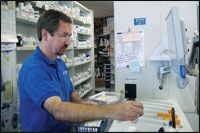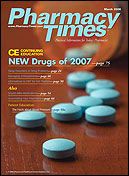Publication
Article
Pharmacy Times
A Robotic Touch?Automating Your Pharmacy
Author(s):
Automating prescription fulfillment functions can lower costs, reduce errors, and give pharmacists more time with patients.
Ms. Heinze is a freelance writer based in Vancouver, British Columbia.
Matt's Medicine Store in Independence,Missouri, was facinga problem not uncommonto many community pharmaciestoday: The volume of prescriptions wasincreasing, and the staff was finding itdifficult to keep up with the workload.

Matt Mallinson, RPh
"We close at 6:00,and we were not gettingout of here until8:30," explained MattMallinson, RPh, owner."Employees weredisgruntled, obviously,and we were allmissing family eventsthat we should havebeen going to. It wasa work environment that just wasn'tvery comfortable; we had to do somethingto be able to do more prescriptionsand get them out of here."
Mallinson knew the answer: By automatinga large portion of his store'sprescription fulfillment, turnaroundtime would decrease, and not onlywould he and his employees get outthe door when they should, but hisbusiness in general would becomemore streamlined. He spent 3 years researchingvarious automation options,finally settling on a ScriptPro SP 200—arobot with the capacity of dispensing200 different drugs.
"The biggest time waster is the manualpreparation of prescriptions: thecounting of pills into the bottle, thepeeling off of the label, attaching it, gettingthe bottles off the shelf and puttingthem back, making sure that youhave the right bottle and dumping theexcess pills back intothe bottle," explainedMike Coughlin, presidentand chief executiveofficer (CEO) ofScriptPro in Mission,Kansas. "When youlook at all of the stepsthat a pharmacy goesthrough in startingwith a piece of paperand ending up with a prescription—labeled, with the drugs in it—there is alarger number of steps to go through."

Mike Coughlin,President andCEO of ScriptPro
Not only does a robot perform thesetasks automatically, it may be replenishedat the pharmacist's convenience.Most importantly, it reduces the potentialfor human error.
Fewer Errors, Lower Costs
"There is huge error reduction,"Coughlin emphasized. "You are handlingthe drugs once, because you aretaking a bulk stock bottle and you arepouring it into the machine. If you followthe procedure of bar-code scanningand matching the bottles, then allof those drugs that are loaded at thebeginning of the day or the nightbefore are going to be accurate."
For Mallinson, the decision to automatewas a natural progression. "Mostof us know that our volume is going tobe increasing, and our profit marginsare continuing to decline," he said. "Wehave 3 choices in our profession rightnow: We may wait for retirement, sellout, or automate and continue in business."Although the purchase of themachine required a considerableinvestment up front, it has saved thepharmacy money in the long run. Itcosts roughly $1.25 to fill a prescriptionwith automation, versus about $4.25with an employee.
Inventory Efficiencies

Jim Wilson, RPh,MBA
Inventory management—one of thebiggest challenges that any businessfaces—is made easier because thesesystems track stock in real time. "Withautomation, there is no getting aroundthat; they actuallyreplenish inventorywhen they stock themachine, the machinecounts it alland they know howmuch they are dispensingand exactlywhat they need, andthey can calculate reorderrates so theydon't run out," said Jim Wilson, RPh,MBA, president of Wilson Health Information,LLC, in New Hope, Pennsylvania.
Mallinson's inventory costs have alsogone down, despite the argument thatthe initial loading of a robot requires asignificant inventory investment upfront. "When I ran my top 400 productsto figure out which top 200 I wanted toput into the machine, I saw that I wasbuying 3 to 4 bottles of a certain drug amonth anyway," he explained. "If I buythem 2 at a time and fill the machineup, what's the difference in buyingthem 2 at a time every 2 weeks, or 1every week?"
Because of the time that he saves onprocessing prescriptions, Mallinson isfree to seek better deals on inventoryas well. "My inventory costs went downbecause, if you're staying at workevery night until 9, you don't have thetime to look at the cost of goods. Now,with the robot, I have a little extra timeto look at my cost of goods," he said,adding that he is saving half the cost ofthe machine per month by shoppingaround for generics. "That is not theadvantage of the machine, but theadvantage of me having more time andbecoming a better businessperson."This also enables Mallinson and hispharmacists to spend more time withpatients, and, consequently, he hasnoted an increase in OTC sales.

Matt Mallinson, RPh, uses ScriptPro 200 technology to verify a prescription at hispharmacy in Independence, Missouri.
At first, Mallinson admits that hewas worried that patients would bereticent to accept their prescriptionsfrom a machine; however, that concerndissipated as he examined howmany other automated sources theydo business with. "You start realizingthat we have become an automatedsociety, and the consumers accept it,"he said. "They are accepting their prescriptionsthrough the mail, so there isnot an issue with it—especially whenyou explain to them that it's error-freeand that is does not grab the wrongbottle."
Mallinson notes that the installationand training period was relativelyseamless. The incorporation of themachine did not require the pharmacyto undergo a major overhaul, andemployees were comfortable with therobot in a matter of several days.ScriptPro technicians were on site toanswer any questions during the firstweek of operation, and Mallinson, oncehaving made the decision to automate,involved his team in the project fromthe get-go. He advises his peers to dothe same and to take their time inresearching the machine that is bestsuited for their operation.
Wilson, too, emphasizes the importanceof conducting a thorough assessmentof the marketplace. "They needto do their due diligence by comparingdifferent systems and meet with themanufacturers to get the full picture—not only how much the robot costs, butwhat the overall cost will be in thescheme of things," he said. "Thingschange, and their volume mightchange 2 years from now. They need tomake sure it is the right machine forthe volume of business that theyexpect to do." Some machines are easierto clean and maintain than others(and therefore less susceptible to creatingissues surrounding cross contamination);some manufacturers offer bettertechnical support. All of these factorsshould be taken into considerationlong before a purchase is made.
Planning for the Future
While not every pharmacy may beready to make the investment that isrequired to implement automation,Coughlin encourages pharmacies todesign their work flow so that it caneventually accommodate robotic systems."In almost every industry, automationis viewed as a fundamental elementof a productive system," he said."You want to make things happen asautomatically as possible, and onceyou've assessed what the automaticfunctions are, you lay out your work flowand your facility design around that."
In the long run, this approach savespharmacies both time and money."Some pharmacies try to hang on withoutgoing to that level, and they end upadding people and implementing lesspowerful systems. Ultimately, they endup with a robotic solution, and theyprobably should have been looking atthat from the start. You need to at leastbe planning it into the design process."







